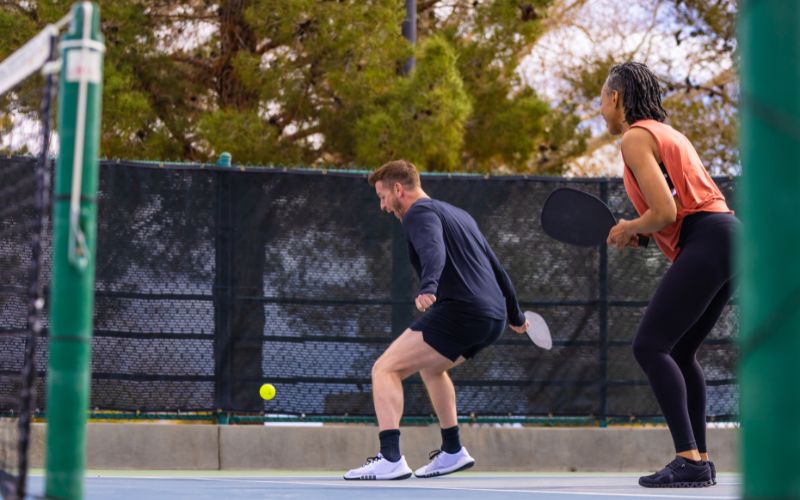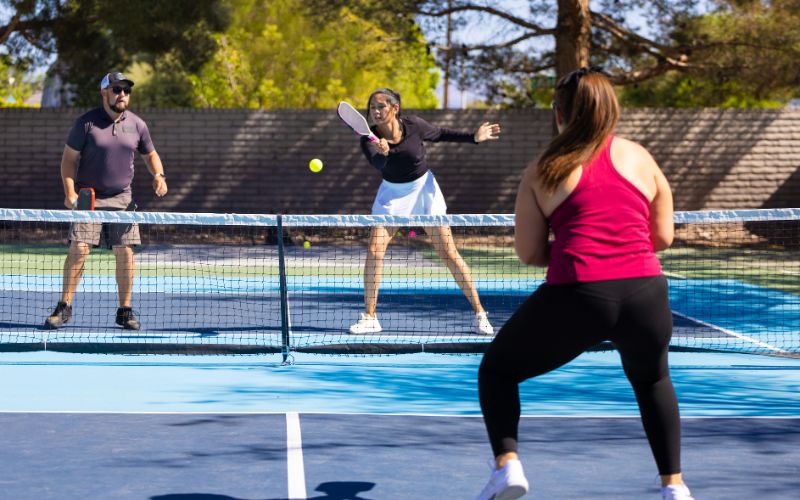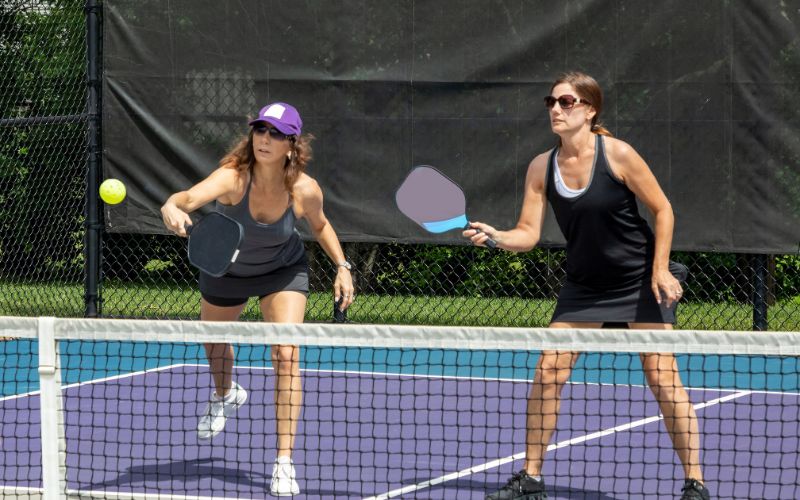Pickleball is more than just a sport; it’s a blend of strategy, precision, and skill. To master the game and win big, it’s essential to understand the nuances that set apart successful players from the rest. In this comprehensive guide, we’ll dive deep into 13 Pickleball Tips & Techniques that will give you an edge on the court. So, grab your pickleball paddle, let’s get started!
1. Deliver Your Serve and Return With Depth, and Maintain Your Position After Serving While Being Prepared to Advance During the Return.
The “Serve and Stay, Return and Run In” strategy is a cornerstone of success. It centers on the concept of delivering serves that penetrate deep into the opposing court. This approach has a dual benefit, applying pressure to your opponents while creating an advantageous position for your team. By serving deep, you force your opponents to defend from the back of the court, making it more challenging for them to launch an offensive attack.
Following the serve, it’s crucial to maintain your positioning near the baseline, remaining in a state of readiness for any potential shots that might come your way. This versatility allows you to adapt to various scenarios, whether it’s covering a well-placed return or moving forward to seize control of the net.
Equally essential is the return aspect of this strategy, where you aim to hit your shot deep into your opponent’s court. This not only maintains your team’s positional advantage but also serves as a proactive measure to control the tempo of the rally, putting your opponents on the defensive and setting the stage for strategic play.
In pickleball, “Serve and Stay, Return and Run In” represents a dynamic blend of offensive and defensive elements. Deep serves exert pressure, while staying near the baseline keeps you ready for swift, well-timed movement forward. On the return, the focus on depth helps in maintaining rally control and can dictate the pace of the game. This strategic approach underscores the importance of position, control, and adaptability, making it an invaluable tool for players seeking to excel in this fast-paced sport.
2. Get up to the kitchen line and Keep Your Paddle Up
Keep Your Paddle Up” is a fundamental component of successful pickleball strategy, and it complements the concept of positioning near the kitchen line (non-volley zone line) to create a dynamic and advantageous game plan. In pickleball, the non-volley zone is a specific area near the net where players are not allowed to volley the ball (hit it out of the air). It’s a crucial region because it’s close to the net and positions you strategically to control the flow of the game.
Keeping your paddle up refers to maintaining a ready and alert posture with your paddle held in a poised position. This stance is essential because it enables you to respond quickly and effectively to incoming shots. With your paddle up, you’re in an ideal position to engage in quick volleys, making it easier to maintain control of the kitchen area. This readiness ensures that you can react promptly to shots, whether they’re high, low, or coming from various angles.
By having your paddle up, you gain a significant advantage in maintaining control of the kitchen area. This control allows you to limit your opponent’s options, as they will have to contend with the constant threat of your well-placed volleys. It not only strengthens your defensive capabilities but also empowers your offensive potential, as you can capitalize on opportunities to put your opponents on the defensive with swift and accurate shots.
3. Embrace the Opportunity to Play Pickleball in Singles, and Don’t Shy Away From Mastering the Non-volley Zone or the Kitchen.
Playing alone, often referred to as “singles,” is an exceptional method to refine your skills. It demands that you cover the entire pickleball court by yourself, fostering agility, enhancing shot placement, and advancing your overall gameplay.
In singles matches, you are solely responsible for defending your side of the court and executing strategic shots, which can significantly sharpen your ability to adapt to various situations and improve your decision-making on the fly. The experience gained from singles play is invaluable for players looking to develop their individual skills and become well-rounded competitors.
Simultaneously, “Don’t Be Afraid of the Kitchen” encourages players to view the non-volley zone (the kitchen) as an asset rather than a limitation. Mastering the kitchen is fundamental in both singles and doubles play.
This area near the net allows you to dominate the net, control the pace of the game, and limit your opponent’s options. By not shying away from the kitchen, players can gain a strategic edge. It reinforces the notion that being close to the kitchen is not a restriction but an advantage that smart players can exploit.
Embracing the kitchen empowers players to utilize quick volleys and well-placed shots to maintain control of the game, emphasizing its importance as a critical aspect of successful pickleball strategy.
4. Target Your Opponent’s Weaker Backhand Side and Ensure You Employ the Appropriate Grip.
Use the Right Grip” is a crucial element of effective pickleball strategy, complemented by the strategy of identifying and capitalizing on your opponent’s weaknesses. A player’s grip on the paddle plays a significant role in their ability to execute various shots with precision and versatility.
The continental grip, which is widely recommended in pickleball, offers this much-needed versatility. It allows players to seamlessly transition between forehand and backhand shots, adapting to different scenarios during a match. By employing the right grip, you can maximize your shot options and remain ready to respond to various situations, giving you a competitive advantage on the pickleball court.
Incorporating the right grip into your game is essential when targeting your opponent’s weaknesses. Most players tend to have a weaker backhand, making it a prime target for your shots. With the continental grip, you can easily direct your shots to exploit this vulnerability. By consistently attacking your opponent’s backhand, you put them on the defensive and create opportunities for offensive plays.
5. Be Mindful of the Wind, and Opt For Crosscourt Dinking as Your Primary Strategy
Paying attention to the wind” is a practical tip for outdoor pickleball games. Wind can significantly impact the trajectory and control of the pickleball. By observing the wind’s direction and intensity, players can make necessary adjustments to their shots, ensuring greater accuracy and control.
This attention to detail can be particularly crucial in windy conditions, as it helps players anticipate how the wind may affect the flight of the ball, allowing for more reliable shot placement and reducing the risk of errors.
Additionally, “Dinking cross court (most of the time)” is a specific strategy that aligns with wind conditions. When employing the dinking technique, which involves playing softly and close to the net, hitting the ball crosscourt can be a more reliable choice when it’s windy.
This approach minimizes the impact of the wind, as the ball travels less distance and is less affected by gusts or breezes. By using this strategy, players can maintain control and consistency in their shots, ensuring a competitive edge even when dealing with challenging wind conditions during their outdoor pickleball games.
6. Vary Your Shot Selection and Maintain a Relaxed Grip for Executing Gentle, Soft Shots.
Consistently changing the speed, angle, and spin of your shots can keep your opponents uncertain and off balance. It adds an element of unpredictability to your gameplay, making it challenging for your adversaries to anticipate your next move.
By mixing up your shots, you create a strategic advantage, as your opponents won’t be able to settle into a rhythm or effectively counter your plays. This variety in your shot selection is a powerful tool in maintaining control and dictating the pace of the game.
Using a “Loose Grip for Executing Gentle, Soft Shots” complements the idea of shot variety. A loose grip enables you to generate soft shots with finesse and precision. While power is essential in pickleball, soft shots can catch your opponents off guard. These softer shots can be placed more accurately and often make it challenging for your rivals to react swiftly.
By having the versatility to transition between a firm and a relaxed grip, you can introduce a change of pace into your game, confounding your opponents and enhancing your overall shot selection. This dual approach, emphasizing shot diversity and grip adaptability, is a strategic combination that can lead to more successful and unpredictable play on the pickleball court.
7. Maintain a Low Trajectory for the Pickleball and Become Proficient in Executing Third Shot Drops.
The third shot drop in pickleball is a crucial one. It’s the drop shot that transitions the pickleball game from the serve-and-return phase to the dinking phase. To execute it well, focus on keeping the pickleball low and just barely clearing the net. This forces your opponents to hit up, making it more challenging for them to attack.
8. Stay Patient
Patience is a virtue in pickleball. Avoid the temptation to rush into aggressive plays. Instead, use your partner strategically. Work together to control the kitchen and wait for the right opportunity to attack.
Be in “Pickleball Ready” with Your Pickleball Paddle Up
Want More Pickleball Strategy Tips and Techniques?
Being in a “pickleball ready” position means having your paddle up and ready to react to incoming shots. This stance allows you to be quicker on your feet and better prepared to respond to the unpredictable nature of pickleball.
Success is a tantalizing blend of pickleball technique, strategy, and an understanding of the game’s nuances. When starting to play pickleball, these 13 Pickleball Tips & Techniques serve as your roadmap to achieving big wins on the court. Let’s delve into the arsenal of skills that will elevate your game.
“Serve and Stay, Return and Run In” encapsulates a strategy that applies relentless pressure on your opponents. The power of deep serves and calculated returns lies in the disruption of your opponents’ rhythm. This tactical maneuver places you in a favorable position and keeps your adversaries on the back foot, forcing them to react defensively. Maintaining proximity to the baseline post-serve allows you to adapt swiftly to varying situations, whether you’re covering a return or advancing to seize control of the net. Equally crucial is understanding the return aspect, where deep shots into your opponent’s territory set the tempo and dictate the flow of the rally. This strategy underscores the significance of maintaining control, positioning, and adaptability, making it a critical tool in your pickleball arsenal.
“Get up to the kitchen line, Keep Your Paddle Up” emphasizes the significance of dominating the non-volley zone (kitchen). Proximity to this zone grants you a distinct advantage, limiting your opponent’s choices and enhancing your control. With your paddle poised and ready for swift volleys, you’re primed to maintain your dominance in this crucial region.
Whether you’re a newcomer to the world of pickleball or a seasoned player honing your technique, these tips and techniques will enhance your performance. The game’s unpredictable nature demands a readiness that “Pickleball Ready” provides, sharpening your reaction time and enabling you to seize the moment. So, take these lessons to heart, master your important shots, and embark on your journey towards pickleball greatness.
Frequently Asked Questions
What are some key strategies for winning in pickleball mentioned in the article?
The article discusses various essential strategies, such as hitting your serves and returns deep, employing the “Serve and Stay, Return and Run In” strategy, getting close to the kitchen line, using the right grip, and paying attention to wind conditions.
How can playing singles or alone in pickleball help in skill improvement, as suggested in the article?
Playing singles or alone in pickleball forces players to cover the entire court, develop shot placement, and improve overall skills. It’s an excellent way to enhance your game by increasing your ability to adapt to different situations.
Why is the “Serve and Stay, Return and Run In” strategy considered crucial in pickleball?
This strategy involves delivering deep serves and returns, putting pressure on opponents and creating a favorable position for your team. By serving deep and maintaining readiness near the baseline, you can adapt to different scenarios, maintain control, and dictate the tempo of the game.
How does being in a “Pickleball Ready” position with your paddle up benefit your gameplay?
Being in a “Pickleball Ready” position with your paddle up allows for quicker reactions to incoming shots. It enhances your readiness and adaptability in the unpredictable nature of pickleball, giving you an advantage on the court.
Can you elaborate on the importance of a loose grip and why mixing up shots with different speeds, angles, and spin is essential, as mentioned in the article?
A loose grip helps generate soft shots for better control and finesse, which can surprise opponents with a change of pace. Mixing up shots with various characteristics keeps opponents guessing and adds versatility to your gameplay.







